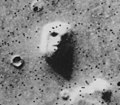Pareidolia
Pareidolia (pronounced /pɛɹaɪˈdoliə/ or /pæraɪˈdəʊliə/), first used in 1994 by Steven Goldstein[1], describes a psychological phenomenon involving a vague and random stimulus (often an image or sound) being mistakenly perceived as recognizable. Common examples include images of animals or faces in clouds, seeing the man in the moon, and hearing hidden messages on records played in reverse. The word comes from the Greek para- – amiss, faulty, wrong – and eidolon – image, the diminutive of eidos – appearance, form. Pareidolia is a type of apophenia.
Explanation
As a survival technique, human beings are "hard-wired" from birth to identify the human face. This allows people to use only minimal details to recognize faces from a distance and in poor visibility, but can also lead them to interpret random images or patterns of light and shade as being faces.[2] Skeptics assert that sightings of religious or iconic figures in everyday objects, such as Marian apparitions, are examples of pareidolia, as are some cases of electronic voice phenomena. The Face on Mars is a phenomenon that succeeded the Martian canals, both eventually attributed to pareidolia, when the "seen" images disappeared in better and more numerous images. Many Canadians thought they saw the face of the Devil in the Queen's hair on a dollar bill in the 1954 series, adapted from a photograph. The bills were not withdrawn from circulation, but the image was altered in its next printing.
A similar phenomenon is the clustering illusion.
The Rorschach inkblot test uses pareidolia to attempt to gain insight into a person's mental state. While this test is still widely employed, its scientific basis is disputed, and no studies have shown empirical confirmation of success.
The publicity surrounding sightings of religious figures and other surprising images in ordinary objects, combined with the growing popularity of online auctions, has spawned a market for pareidolic items on eBay. One famous instance was a grilled-cheese sandwich with the Virgin Mary's face.[3]
References
- ^ McFedries, Paul. "Word Spy - pareidolia". Retrieved 2006-06-13.
- ^ Sagan, Carl (1995). The Demon-Haunted World - Science as a Candle in the Dark. New York: Random House. ISBN 0-394-53512-X.
{{cite book}}: Cite has empty unknown parameter:|coauthors=(help) - ^ "'Virgin Mary' toast fetches $28,000". BBC News. 23 November 2004. Retrieved 2006-10-27.
{{cite news}}: Check date values in:|date=(help)
Gallery
-
This alarm clock appears to have a sad face.
-
The "devil's head" illusion on the 1954 Canadian dollar
-
A satellite photo of a Mars rock, with shadows creating the famous Face on Mars
-
A tree in the shape of a person in an Islamic prayer position
-
A door handle
See also
- Face perception, for the cognitive process
- Ghosts as an artifact of Pareidolia
- Paranoiac-critical method
- Religious pareidolia
- Simulacrum
- Other natural examples
External links
- Yoism Video and photographic demonstrations of pareidolia
- Fortean Times examples of pareidolia in nature
- Template:Es icon Examples of pareidolia
- Skepdic.com Skeptic's Dictionary definition of pareidolia
- A dragon on a Mexican river (Google Maps)
- Lenin in my shower curtain (Bad Astronomy)
- Series of images from the news
- Koranic inscription on a fish
- The Stone Face: Fragments of An Earlier World
- Tomato with 'human face' creates sensation in Kyoto
- Natural phenomenon of Allah's Name, in Arabic
- The Pareidolia Museum By Karen Stollznow
- [1] Feb. 13, 2007 article in New York Times about cognitive science of face recognition.



